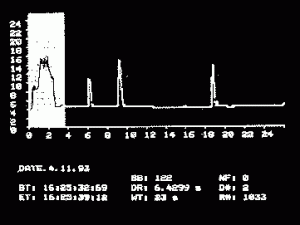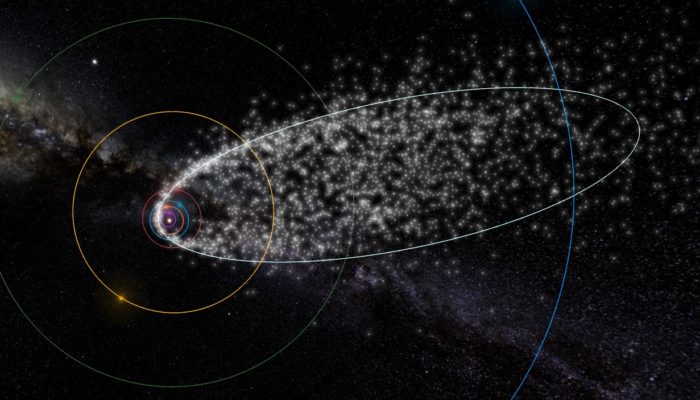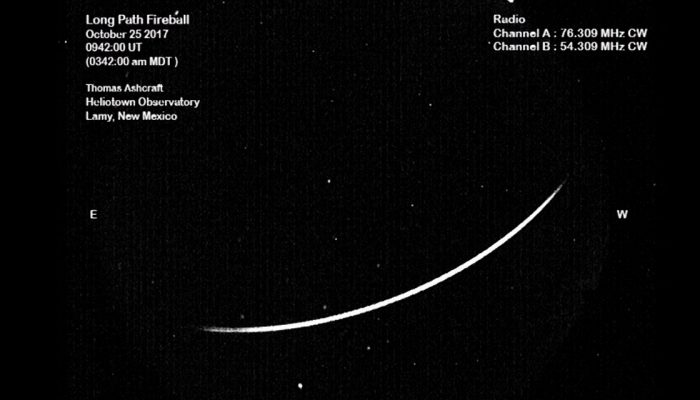An Introduction to Meteor Radio Scatter

An example of the Apple IIe “strip-chart” display (received power vs. time) from the Poplar Springs Radiometeor Station. This station operated from 1993 to 1998 in northwestern Florda.
Whenever a meteor passes through the upper atmosphere it creates a column (actually an elongated paraboloid) of ionized air behind it tens of kilometers (km) long, called a meteor trail. Occurring at an atmospheric height of about 85 to 105 km (50 to 65 miles), this ionized trail is capable of reflecting radio waves from transmitters below on the Earth’s surface. This type of reflection behaves very similar to light reflecting from a mirrored surface, and is called a specular reflection. Meteor trail reflections are brief, however. As the trail rapidly diffuses into the surrounding air, it quickly loses its ability to reflect radio waves, causing most reflections to last less than 1 second. Occasionally, a large meteor may create a trail capable of reflecting radio waves for up to several minutes. Meteor radio wave reflections are also called meteor echoes or events.
If the radio waves from the transmitter below strike the meteor trail at a perpendicular, or right angle, then the reflected signal will be directed back towards the transmitter itself. This is called back-scatter, and a station set up to receive such signals is called a meteor radar. Back-scatter is one of the most common methods by which professional astronomers study meteors using radio waves. These reflections can be used to study the meteors which caused them because each meteor will generate a unique signal based upon its mass, velocity, angle and direction of entry into the atmosphere, and distance from the transmitter. If the radio wave from the transmitter strikes the meteor trail at some incident angle other than perpendicular, then the reflected signal will be projected to some point on the ground some distance away from the transmitter. This is called forward-scatter, and the area on the ground where the signal has been reflected is called a forward-scatter footprint. This footprint will only be a few km wide and several km long. Meteor trails can reflect radio signals over distances of up to 2000 km (1200 miles) between a transmitter and receiver. most forward-scatter systems, however, operate at a distance of about 300 km to 1500 km (175 to 925 miles).
The forward-scatter of radio waves by meteor trails can serve two important purposes:
First, the trails can be used to send brief encoded messages to distant receiver sites. This is called meteor burst communications, and is frequently used as a backup means to satellite communications. In North America, the most widely known meteor burst communications system is the SNOTEL system (40.670 MHz), used by the U.S. Natural Resources Water and Climate Center, located in Portland, Oregon, to monitor rain and snowfall levels at remote stations throughout the Rocky Mountains. These stations are fully automated weather stations and meteor burst transceivers, which relay their information to a master station upon command. In addition, amateur radio enthusiasts, operating in the VHF bands, also make frequent use of meteor scatter (MS) , during major meteor showers but the frequencies used occur anywhere in the legal bands and are intermittent.
The second purpose for forward-scatter is the study of meteors, and is similar to that performed by the back-scatter systems. The advantage of this method is that transmitters broadcasting for purposes other than meteor radio scatter can be utilized, thus allowing the construction of a receiving station only by the researcher. The disadvantage of this research method is that the geometry is much more complex than in the back-scatter condition, making meteor parameters more difficult to determine.
The AMS Radiometeor Project
For nearly sixty years the American Meteor Society (AMS) has encouraged its technically inclined amateur members to experiment with the establishment of forward scatter receiver systems. First successes in this area were had by the Kansas Meteor Group, an AMS affiliate, in 1958. This group, led by Walter Scott Houston, established an automatic electronic system for counting meteor echoes from a professionally operated transmitter located in Cedar Rapids, Iowa. Featured in the July, 1958, Scientific American, this system remained in operation until the early 1960’s.
During the mid-1970’s, the advent of the personal computer made it possible for amateurs to establish forward-scatter data collection systems of an even higher level of sophistication. In order to germinate this potential within the amateur community, the AMS Radio Scatter Program was created by Dr. David Meisel in 1977. The purpose of this program was to establish a network of amateur operated forward-scatter receiving stations across a wide geographic area, each station automatically collecting data on the incoming meteor flux on a continuous 24-hr day basis. The data collected from these stations would then be used in the research conducted by AMS affiliated professional astronomers. During the decade of the 1980’s, this program carried out experiments involving the establishment of meteor radio scatter receiving stations by groups of amateur astronomers, as well as preliminary work in using microcomputers for data collection. Notable successes included the work of William Black (1983) of Florida; Michael Owen (1986) of New York; and Meteor Group Hawaii, led by Michael Morrow and George Pokarney (1987). The most promising results were the experiments performed by Kenneth Pilon (1984), a Canadian amateur, who successfully demonstrated that a TRS-80 personal computer could be used to detect and make graphic printouts of meteor events.
Building upon the lessons learned from these previous attempts, the first full-time prototype station for the AMS became operational in March, 1993, utilizing an economical Apple IIe platform for data collection. This station was located in the rural countryside of northwest Florida (Poplar Springs) , and utilized distant Television Channel 2 transmitters as its signal source. In late 1993, the AMS Radio Scatter Program was reorganized, and became the AMS Radiometeor Project. For several years, efforts were focused upon expanding the network, as well as increasing the reliability and sophistication of each individual station. Three stations were eventually established, located in California, Florida, and Virginia. Professional analysis of the collected data yielded several conference talks and an extensive paper in the European journal Planetary and Space Science (Meisel and Richardson, PSS 47, 107-124,1999) Nearly 8 years of data were collected, but little has been completely reduced although reduction programs written in any modern version of the Mathematica language can still read the old format data files is still being maintained. Soon after that paper was published, the AMS Project was eventually shut down because it depended critically on the use of low VHF analog TV Ch. 2 stations that broadcast programs 24h per day, 7 days a week. The problem was the looming nation-wide mandated analog to digital change over. Digital television was authorized in 1996, but by late 2000, most of the useful analog transmitters that the AMS program used were being retired although the final digital change to UHF frequencies was nearly a decade later.
Starting (or Restarting) a Passive Radiometeor Project in North America
Amateur radio operators in North America continue to use VHF/UHF meteor forward scatter for point to point communication, but like SNOTEL their transmissions are not continuous in time. Several times since 2000, meteor enthusiasts in the US with radio expertise have found certain low power HF and VHF transmitted frequencies including specific amateur radio “propagation” beacons (https://en.wikipedia.org/wiki/Amateur_radio_propagation_beacon) useful for their personal use, but regional (or national) reception of these are not dependable enough to be considered for long-term meteor detection purposes as was the previous AMS effort. Not only was lack of high transmitter power a problem, but many amateur beacon transmitting antennas lack the achievable low angle gain that could match that of previous US VHF TV channels.
In Europe and Japan, several “official” continuously operating “beacon” stations still survive and so it is not as difficult to set up and maintain a reliable meteor radio project in those locations. One of the reasons that monitoring the upper HF and VHF bands is more important in some locations and not others is that Eastern/South Eastern Europe and Japan have higher probabilities of sporadic-E ionospheric disturbance (https://swc.nict.go.jp/en/knowledge/ionosphere.html#sporadic_e-layer) than other localities in the northern hemisphere. For example, recently, the discovery of sporadic E disturbance of the standard aircraft navigation frequencies has led to development of a network of inexpensive Es monitoring stations across Japan ( https://link.springer.com/article/10.1186/s40623-020-01216-z and http://gwave.cei.uec.ac.jp/cgi-bin/vor/vhf.cgi ) Sporadic E does have connection with meteors that is complicated and not well understood (and no attempt is made here to describe the details), but it is noted here only that Es episodes across Florida were a major disturbance for the previous AMS Radiometeor Project.
With the disappearance of most analog TV stations in the US and Canada (with possibly a few known Canadian exceptions), finding acceptable substitute frequencies for serious radio meteor study was an arduous task and subsequently those who were not already radio enthusiasts lost interest, not only in radio meteors, but in meteor science itself. However, some persistent amateurs found a loop hole in the DTV process that at least for some locations enabled meteors to be detected with what became fairly “simple” equipment, SDR (software defined radio) attached to personal computers.
The loophole is that in order for widely-touted digital to analog converters to work properly in a given coverage area, each “new” DTV station arrangement would emit a “pilot” signal that would be located inside the former analog band.
The 8-VSB modulation used in ATSC (DTV) has a pilot carrier that serves as a reference frequency for DTV receivers and can be heard on an AM or FM receiver. The pilot carrier is approximately 310 kHz (0.31 MHz) above the lower band edge. The exact frequency used may vary because the transmitted signal may be offset slightly to reduce interference.
US Digital Channels of Possible Meteor Scatter Interest
Ch. DTV(MHz) Pilot, Video, Audio
| 2 | 54-60 | 54.31 | 55.25 | 59.75 | |
| 3 | 60-66 | 60.31 | 61.25 | 65.75 | |
| 4 | 66-72 | 66.31 | 67.25 | 71.75 |
Ch. 2 Stations as Most Likely Candidates for Successful Meteor Detection
The lowest channel listed is Ch. 2 and for technical reasons is most likely to show a consistent meteor response. The following list of Ch. 2 candidates and locations is taken from the Wikipedia article to be non-virtual Ch. 2 DVT transmissions whose pilot is 54.31 MHz. The digital video signal is at 55.25 MHzwhile the audio signal at a factor of ten below the pilot is 59.75 MHz
| Call Sign | City | State** |
| KFTY-LD* | Middletown (3 kW) | California |
| KHIZ-LD* | Los Angeles (3 kW) | California |
| KHME | Rapid City (18.2 kW) | South Dakota |
| KHSV | Las Vegas (27.7 kW) | Nevada |
| KITM-LD* | Lahaina (~800 W) | Hawaii |
| KNOP-TV | North Platte (16 kW) | Nebraska |
| KQRO-LD* | Morgan Hill (~3 kW) | California |
| KREX-TV | Grand Junction (~800 W) | Colorado |
| WDPN-TV | Wilmington (34 kW) DE | (Philadelphia Pa) |
| WGGS-TV | Greenville (33 kW) | South Carolina |
| WHDF | Florence ( 21 kW) | Alabama |
| WLBZ | Bangor (3 kW) | Maine |
| WSBE-TV | Providence (10 kW) | Rhode Island |
| WYCX-CD* | Manchester (1.56 kW) | Vermont |
*List as low power. **Transmitter site may be elsewhere. See Wiki listing or https://fccdata.org/ for Long/Lat of transmitter/antenna.
Apparently the first use of DTV (pilot) Ch. 2 or Ch.3 for meteors scatter was by Stan Nelson KB5VL, Roswell NM with others sharing on the RoswellMeteor.com website, mostly from the western US or Mexico (http://www.roswellmeteor.com/index.html). Meteor activity on WWV 25 MHz has also been shown online by Nelson and Dennis Condron K0LGI in Iowa. DTV activity has been shown from Hermosillo, Mexico by Dr. S. Aguirre and KE7KRF (Richard) from Arizona. Which stations are suspected to be the transmitters of the received DTV signals is not stated, but at least for Roswell for which the antenna is said to be pointed west, KHSV (Las Vegas) is most likely with KNOP (North Platte,NB) and KHME ( Rapid City, SD) possible.
Note on WWV: According to the WWV webpage (https://www.nist.gov/pml/time-and-frequency-division/radio-stations/wwv), currently (09/05/2020) the 25 MHz broadcast is experimental with a half-wave vertical dipole antenna at 2.5 kW and is said to be “typically” continuous. The antennas at the other frequencies 2.5, 5, 10,15 and 20 MHz are single quarter wave vertical at the top with 9 quarter-wave tower to ground supports at 45 degree angles from the tower attachment to ground. Thus “local” as well as DX reception is accommodated. Powers are 2.5 kW on 2.5 and 20 MHz and 10 kW on 5,10, and 15 MHz.
Ch. 2, Ch. 3 Canadian Analog Stations (Operating ?)
Finally, Curtis Phillips, Palm Bay Florida, pioneered long distance meteor scatter from one of the few Ch. 2 analog stations left (as of 2017) in North America, CHBX-TV Sault St. Marie, Ontario, Canada. This station has been reported to still be transmitting (https://fccdata.org/?lang=en&cantv=CHBX-TV) . Its analog video is at 55.25 MHz (100 kW ERP) and audio 59.75 MHz (10 kW), but the antenna pattern is maximum at 340 degrees (NW) azimuth and minimum (90 dB down) at 135 degrees (SE) . The transmitter is 46.594 degrees North and 84.35 West. Reception in Palm Bay was just at the limit of 1 hop E-layer reflection so only the highest and fastest meteors were sampled with the lower detection height limit severely dependent on the low angle antenna response resulting in considerable signal analysis ambiguity.
Individuals desiring to monitor meteor activity via digital pilot frequencies from locations in Southern Canada and the Northern US should probably check out whether any of the Canadian analog stations like CHBX-TV are still operating, at least intermittently, or not. Analog signals are easier to interpret than digital ones and thus in principle are easier to analyze. CHBX-TV is currently listed as a “CTV station” https://en.wikipedia.org/wiki/CTV_Television_Network as an analog only station along with CITO (Timmons, Ontario, Ch.3). CTV also lists Regina, Saskatchewan, digital Ch. 2.1 (8 kW) and Edmonton Alberta, digital Ch 3.1 (12 kW). The frequencies are listed above. Additional transmitter details can be obtained by entering the station call sign into the search field shown on https://fccdata.org/. One of the things that made the old analog TV frequencies really valuable for meteor work was 24 hour/7 day a week operation. It is not known if any of the today’s (2020) over-air transmissions (analog or digital) are of this nature. and this may be a problem for long-term meteor projects.
Radiometeor Information, Observing Networks and Software
- RoswellMeteor near real time meteor and solar monitoring from New Mexico and Iowa – Stan Nelson and
Dennis Condron - The ideal receiving antenna for meteor studies needs to be truly omnidirectional. Below is a link to an example of a professional design that fulfills that goal, but before investing in such a complex active antenna, confirmed meteor reception should first be checked with (a) a simple vertical dipole, (b) straight wire broadside to the azimuth direction to the transmitter/antenna location, or ( c) a simple rotatable loop antenna attached to a modern SDR (software defined radios) perhaps equipped with a HF/VHF converter and preamplifier.
- ActiveCrossed Dipole
- Some Notes and Equations for Forward Scatter compiled by James Richardson
- The Meteor Meniscus: Meteor Distance verses Meteor Zenith Angle by James Richardson
- AMS Radiometeor Project Bulletin 203 compiled by James Richardson
Details of European efforts as well as some North American ones can be gleaned online.
Revised 09/25/2020 by D. Meisel
 American Meteor Society
American Meteor Society

